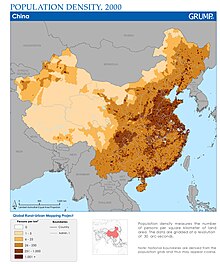Heihe–Tengchong Line
This article needs additional citations for verification. (August 2013) |


The Heihe–Tengchong Line (simplified Chinese: 黑河–腾冲线; traditional Chinese: 黑河–騰衝線; pinyin: Hēihé–Téngchōng xiàn), also called the Aihui-Tengchong Line (and internationally as the Hu line), is an imaginary line that divides the area of China into two parts with contrasting population densities. It stretches from the city of Heihe in the northeast to Tengchong in the south, diagonally across China. The eastern portion, area shown in red in the map, is further subdivided into north and south halves.
As of 2015, 94% of China's population live east of the line, in an area that is 43% of China's total, whereas 57% of the Chinese territory is west of the line has but only 6% of the country's population.
History[edit]
Chinese population geographer Hu Huanyong imagined the line in 1935 and called it a "geo-demographic demarcation line". As this line was proposed in 1935, the map of China at the time included Mongolia (whose independence China did not recognise until after WWII) but excluded Taiwan (which was a colony of Japan at the time).
Demographic trend[edit]
1935 statistics[edit]
This imaginary line divides the territory of China as follows (going by 1935 statistics):
- West of the line (including Mongolia): 64% of the area, but only 4% of the population (1935)
- East of the line: 36% of the area, but 96% of the population (1935)
2002 and 2015 statistics[edit]
Despite a large scale urban migration mainly towards coasts but also trending south, 2002 and 2015 statistics remain nearly identical vis-à-vis the line:
- West of the line: 57% of the area, but only 6% of the population (2002)[1]
- East of the line: 43% of the area, but 94% of the population (2002)[1]
The major change in area between 1935 and 2015 is attributed to China acknowledging the independence of Mongolia after the Yalta Conference. The minor change in total population percent from 1935 to 2015 is attributed to Han Chinese migration to urban areas west of the line, as well as one-child policy restrictions on the majority, with exceptions for largely-minority groups west of the line. However, during the 2000-2015 period, population in the west of the line indeed grew faster than the east, but the growth was not sufficient to budge the rounded percentages. Most of this growth was contained in the cities of Ürümqi, Lanzhou, Ordos, and Yinchuan, although some tribal non-city areas also registered high growth.[2]
Present statistics[edit]
This section needs expansion with: with addition of present statistics and socio-economic conditions. You can help by adding to it. (June 2020) |
See also[edit]
- Qinling–Huaihe Line, further subdivides eastern China in northern and southern halves
- Physiographic macroregions of China
- China Proper
- 100th Meridian West, similar dividing line in the United States
- Administrative divisions of China
- Template:PRC provinces big imagemap
- Autonomous administrative divisions of China
- Autonomous regions of China
References[edit]
- ^ a b Naughton, Barry (2007). The Chinese Economy: Transitions and Growth. Cambridge, Massachusetts: MIT Press. pp. 18–19. ISBN 978-0-262-14095-9.
- ^ W, She (15 August 1998), "Hu Huanyong: father of China's population geography", China Population Today, 15 (20): 20, PMID 12294257
